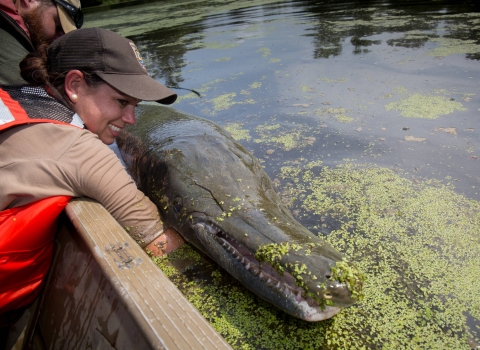Management and Conservation
The Private John Allen National Fish Hatchery produces Alligator Gar, Lake Sturgeon, Gulf Coast Striped Bass, Gulf Coast Walleye, Largemouth Bass, Bluegill, Redear Sunfish, Channel Catfish, Yazoo Darter, Pearl Darter, Piebald Madtom, and Frecklebelly Madtom. Majority of these fish are stocked annually in reservoirs, lakes, rivers, and creeks across the Southeast Region.
Our Services
Private John Allen is considered a warmwater hatchery because the species of fish raised in our ponds have optimal growth rates in water between 75- and 85-degrees Fahrenheit. The hatchery raises fish that are important to the fishery resources of Mississippi, the Lower Mississippi River Alluvial Valley and the Gulf Coast, and stocks fish in cooperation with state game and fish agencies. The water for the hatchery comes from three separate wells. The well water maintains a temperature around 65 degrees, which allows for cool water species, like Lake Sturgeon, to be raised in our holding house building. The hatchery continuously develops new culture systems to propagate at-risk species such as the Yazoo Darter, Pearl Darter, Piebald Madtom, and Frecklebelly Madtom.
Our Projects and Research
The Private John Allen National Fish Hatchery has continuously worked to develop, modify, and research the most effective and efficient methods to spawn, produce, rear, raise, release, monitor, and assess threatened, endangered, at-risk, and native species. Improving these methods for species such as Alligator Gar, Lake Sturgeon, and Gulf Coast Walleye, the hatchery has also shifted its focus towards small bodied freshwater fishes that are native to the state of Mississippi, and are at-risk species; such as, Yazoo Darter, Pearl Darter, Piebald Madtom, and Frecklebelly Madtom. The hatchery continuously develops new culture systems to propagate these at-risk species.
The U.S. Fish and Wildlife Service is working to restore alligator gar (Atractosteus spatula) populations in the Lower Mississippi River Valley. Gar are not currently federally-listed as threatened or endangered. However, in some areas their populations have substantially decreased over the past 50 years prompting most states within their historic range to enact...


